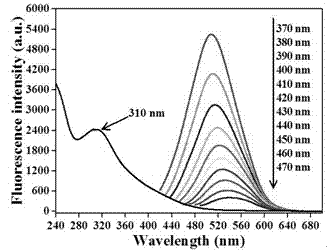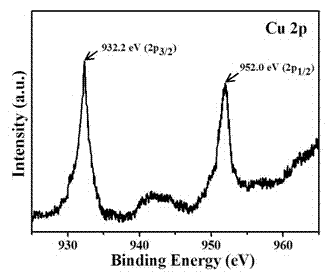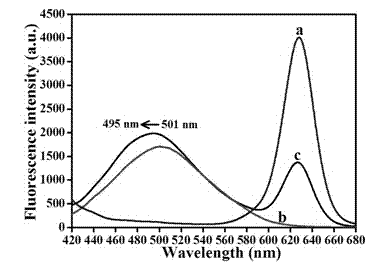Preparation method of quantum dot@Cu nano-cluster ratiometric fluorescent sensor and application thereof in Cu<2+> detection
A ratiometric fluorescent probe, copper nanocluster technology, applied in the field of fluorescence sensing, can solve the problems of high stability and difficulty in preparing extremely tiny particles, improve accuracy, eliminate fluctuations in excitation light intensity, and correct environmental interference Effect
- Summary
- Abstract
- Description
- Claims
- Application Information
AI Technical Summary
Problems solved by technology
Method used
Image
Examples
Embodiment 1
[0019] (1) Preparation of copper nanoclusters: 40 mg of polyethyleneimine was dissolved in 2 mL of ultrapure water, the pH of the solution was adjusted to 5 with acetic acid, and 2 mL of 2 mM Cu(NO 3 ) 2 solution to make Cu 2+ A complexation reaction with the amino ligand in polyethyleneimine occurred for 10 minutes, then 7 mg of ascorbic acid was added to the solution and stirred continuously for 8 hours, and the reaction solution was ultrafiltered at 16,000 rpm with an ultrafiltration tube with a molecular weight of 30 K In 10 minutes, copper nanoclusters are made;
[0020] (2) Preparation of quantum dot copper nanocluster ratiometric fluorescent probe: Mix copper nanocluster solution with 10 mM boric acid buffer solution and CdSe quantum dot solution, add 26.4 μg of 1-(3-dimethylaminopropyl)-3 -Ethylcarbodiimide hydrochloride (EDC), shaking reaction for 2 hours; use ultrafiltration tube with molecular weight of 30 K at 16000 rpm for 5 minutes, and the product is dispersed...
Embodiment 2
[0024] Ratiometric fluorescent probes for the detection of Cu 2+
[0025] (1) Optimization of pH, reaction temperature and reaction time
[0026] The pH, reaction temperature and reaction time were optimized. The results showed that, except for the strongly acidic environment (pH 2+ All have good responses, which may be due to the fact that the amino groups on the surface of CdSe QDsCuNCs are deprotonated under strong acidic conditions and cannot interact with Cu 2+ Complexation is carried out, and then the fluorescence quenching copper amine complex cannot be formed. However, the relative fluorescence intensity of CdSe QDsCuNCs (F 495 / F 625 ) slightly decreased under alkaline conditions, which may be due to part of the Cu 2+ Hydrolysis under alkaline conditions inhibits Cu 2+ Complexation reaction with hPEI-CuNCs. Temperature will affect Cu 2+ The complexation reaction with CdSe QDsCuNCs, the results of temperature optimization show that 37 o C is the optimum ...
PUM
 Login to View More
Login to View More Abstract
Description
Claims
Application Information
 Login to View More
Login to View More - R&D
- Intellectual Property
- Life Sciences
- Materials
- Tech Scout
- Unparalleled Data Quality
- Higher Quality Content
- 60% Fewer Hallucinations
Browse by: Latest US Patents, China's latest patents, Technical Efficacy Thesaurus, Application Domain, Technology Topic, Popular Technical Reports.
© 2025 PatSnap. All rights reserved.Legal|Privacy policy|Modern Slavery Act Transparency Statement|Sitemap|About US| Contact US: help@patsnap.com



